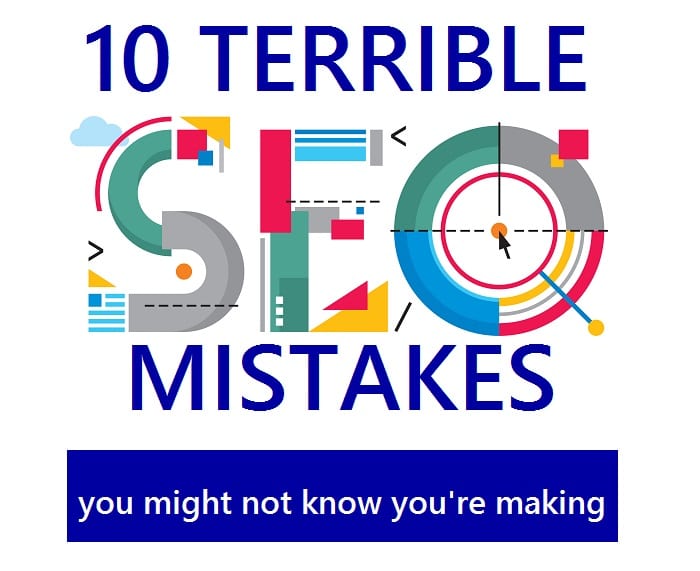Over the last few years,
#1. Duplicate copy
One of the most common and worst mistakes all businesses make is relying on duplicate copy without supporting HTML. For example, I recently came across a chain of medical facilities in different cities and states and each had the same copy, with only contact information changed. The chain wasn’t easy to find…the first facility was on page 38 of the Google search for that specialty.
Duplicate copy is on the top of my list of terrible mistakes most people think are ok. Do yourself an
Some types of duplicate content, such as syndicated posts and news, is fine, as long as you have HTML tags in place to identify it. In the words of Google, “Duplicate content on a site is not grounds for action on that site unless it appears that the intent of the duplicate content is to be deceptive and manipulate search engine results.” Read the Google guidelines for duplicate content to understand how to handle necessary duplication.
#2. Keyword stuffing
Have you ever read copy with a ridiculous long-tail keyword repeated in every paragraph? Believe it or not, that used to be good
#3. Lack of security
Lots of website owners who don’t sell products online seem to feel security is not a priority. Unfortunately, Google does not feel the same way. Last year, they announced that HTTPS sites would be given priority – and that the penalty for unsecured sites would increase over time.
#4. Shady links
Another outdated
Shady link schemes include:
- Exchanging links with other sites (some cross-linking within industry sites is natural)
- Incoming links from low-quality or unrelated sites
- Broken links on your sites (use a broken link checker to find and fix)
The key is to follow the incoming links and make sure they are natural and organic. If the focus of a post is “Finding your dream vacation rental” and you sell an app that locates vacation properties, it’s a natural link. If the article is “What to pack for your vacation,” not so much. A link to your site would seem strange.
#5. Optimized anchor text
Another (relatively) ancient tactic was choose a keyword you want to rank for and include a link to your homepage on every page. A local bakery might use “best Orlando wedding cakes,” for instance, and repeat that phrase on every page. It used to be a good idea, but today, you’re better off just using the company name, or linking to different pages with different anchor text.
#6. Relying on badly written content
Every word on your site reflects your business credibility. Google is focused on delivering the highest quality content to its users. As a site owner, you have several choices for content creation.
You can:
- Do it yourself – authentic voice is fine…actually, more than fine if you’re a good writer and you take the time to find our what your customers want. It’s not as straightforward as it may seem, but owners are passionate about their businesses and that holds a certain charm. If you’re comfortable with writing, show your readers your passion. Your employees may also be willing to write for you – just be sure they have the skills. Quality is paramount.
- Hire a ghost writer – if you have the passion, but not the skill, hire a ghost writer to go over your posts and ideas and organize your writing into quality posts. It’s a great way to get your voice heard in a professional manner. A good one will advise you when you should not tackle a topic.
- Hire a professional writer or service – There are plenty of talented professionals available who will do a great job. Find someone with a writing style you like and email them. Depending on their skill, expertise, and reach, a decent writer may cost anywhere from $30 a post to hundreds. (Those that cost hundreds often supply their own graphics and come with an audience)
What not to do: hire cheap – I don’t advise hiring a cheap writer. Most writers who work cheap return low-quality writing…and a lot of them plagiarize. If their name is not on the writing and you pay them crap, they don’t care how it reads. They only care about how fast they can get words on paper to be paid.
#7. Meta keywords
Yet another old-school tactic that was once good
Title tags are valuable page real estate. Many websites still have their company name as the title tag for every page, and that is so wrong. Titles should be unique to each page, although including the company name is fine. An
One of the sources I researched to write this post was a great article about duplicate content on moz.com. The title tag for the page can serve as a template: “Duplicate Content –
#9. Missing meta descriptions (aka “snippets”)
The meta description on the same moz page is also a great example:
“Duplicate content can be a major source of
It’s 145 characters long, so when it shows up under the title in the search engine, it won’t be truncated. And it tells the user exactly what the page is about. Perfect.
#10. Hiring the wrong SEO company
Sadly, there are still
All of these mistakes are easy to make and hard to avoid if you’re not an
Images: Author’s Own
____________________________________________________________________________________
Tweak Your Biz is a thought leader global publication and online business community. Today, it is part of the Small Biz Trends stable of websites and receives over 300,000 unique views per month. Would you like to write for us?
An outstanding title can increase tweets, Facebook Likes, and visitor traffic by 50% or more. Generate great titles for your articles and blog posts with the Tweak Your Biz Title Generator.



